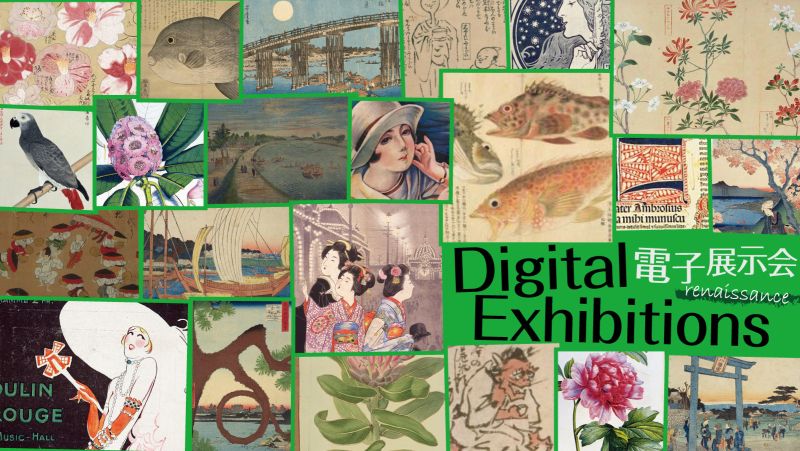Kimodameshi (Test of Courage): Hyaku-monogatari (world of a hundred tales)

On a hot summer night, people gather for the traditional Japanese practice of Hyaku-monogatari, where ghost stories are shared. People lit a hundred candles and told a hundred spooky stories to enhance the ambiance. The exact origin of this practice is uncertain, but it was observed from the Kamakura period (1185-1333) until the Edo period (1603-1867) as a way for samurai families to test their courage. Hyaku-monogatari boomed after the publication in 1677 of a book of ghost stories titled "Shokoku Hyaku-monogatari", read by all social classes, including samurais and commoners.
Since that moment, Hyaku-monogatari became a leisure activity where people gathered in the tatami room to enjoy the ambiance. And this boom led to the depiction of monsters from the stories in nishiki-e.
Hyaku-monogatari of KATSUSHIKA Hokusai
Around the beginning of the Tenpo era (1831-1845), KATSUSHIKA Hokusai created ukiyo-e based on the theme of Hyaku-monogatari with the signature "Iitsu". Though it is Hyaku-monogatari (a hundred tales), Hokusai stopped his production with five pieces. Now let's look into Hokusai's creative world of Hyaku-monogatari (The ukiyo-e prints shown here are reprints from the Meiji period (1868-1912), not from the Tenpo era.)
Above is an ukiyo-e of Okiku, a ghost from the famous kabuki play "Bancho Sarayashiki". The neck of Okiku, which extends like a snake from the well, comprises seven plates. Okiku in Kabuki is a young woman, but Hokusai depicts her as an elderly woman with drooping eyes.
A smiling demoness peeking out of a window has blood on its mouth and horns on its head. She is holding a child's decapitated head. There are various theories about this demoness in this ukiyo-e, such as Kishibojin (the demoness who devoured children) and Warai Hannya, folklore of Nagano Prefecture, but the details are unknown.
Above is a nishiki-e depicting the kabuki ghost story "Tokaido Yotsuya Kaidan". This nishiki-e depicts Oiwa's swollen face as a torn lantern. In this painting, Hokusai depicts a Kabuki scene, "Chochin-nuke," in which the ghost of Oiwa jumps out of a lantern, with his unique sensibility.
The nishiki-e above is the ghost of Kohada Koheiji. Koheiji, a traveling actor, was a character in Santo Kyoden's ghost story Fukushu kidan Asaka no numa", in which he was murdered by his wife's lover, Sakuro, and thrown into Asaka-numa (swamp). It depicts Koheiji as a ghost, haunting the two people who killed him, staring at them as they sleep from outside a mosquito net.
This is a very curious nishiki-e, depicting a Buddhist tablet and offerings. The posthumous Buddhist name on the Buddhist tablet, "Momonjii", is a general name for monsters. The swastika (Buddhist cross) inscribed on the water supply cup is used as Hokusai's pen name, so this may be Hokusai's tablet. The painting itself, condensed into a still-life-like world, may be "persistence".
Hyaku-monogatari by TSUKIOKA Yoshitoshi
In 1865, TSUKIOKA Yoshitoshi (1839-1892), an ukiyo-e artist, published "Wakan Hyaku-monogatari". This is a collection of ghost stories based on Japanese, Chinese, and other bizarre tales. Let's take a look at Wakan Hyaku-monogatari a little.
The above was created based on "Uto Yasukata Chugiden", a kabuki drama written by Santo Kyoden. Yoshikado, the orphaned son of Taira no Masakado, and Princess Takiyasha hime were hiding in the old imperial palace at Soma. This abandoned house had been their father's government office. Oya Taro Mitsukuni, a brave warrior of the Minamoto clan, infiltrated there. To intercept him, Yashahime used witchcraft to make skeletons appear. The above depicts the scene.
The above is the last scene of Shita-kiri Suzume (Tongue Cutting Sparrow), a traditional Japanese fable. It is a story about a greedy old woman who received a large basket from a sparrow, and when she opened it, it was not a treasure but Yokai (monsters). This painting depicts Yokai just popping out of the basket.
The above is based on the Kabuki play "Hakone Reigen Izari no Adauchi (Miracle of the deity at Hakone, the disabled's revenge)". This is a story about Katsugoro taking revenge on his older brother after becoming disabled. Katsugoro's wife becomes a ghost after being murdered and prays to recover her husband's leg and get revenge. It depicts a scene where Katsugoro's retainer, Fudesuke, faces Katsugoro's wife, who has become a ghost.
The above depicts Kayo fujin (Madame Huayang), the empress of the legendary Indian king, Prince Hansokuo. There is a legend that Madame Huayang was actually an evil golden-haired nine-tailed fox who reincarnated for the second time to become a queen and seduced her husband, causing chaos in the country. This painting depicts the queen, who is said to have decapitated 1,000 people, holding a severed head in her left hand, staring at the severed head stuck in a spear.
The above depicts Nyuunryu Kosonsho (Gongsun Sheng), a character from "Suikoden," a military strategist of Ryozanpaku (liáng shān pō) and a wielder who creates wind and calls rain. This painting depicts a dragon emerging from beneath a water spray in a windstorm.
This web page introduces Hyaku-monogatari depicted in nishiki-e. Ghost stories were compiled as Hyaku-monogatari for ghost storytelling meetings, forming the field of early modern ghost stories. In the Meiji period, Hyaku-monogatari was passed down among the fūryū (the literati). For example, literary works such as IZUMI Kyōka's "Yoshiwara Shinwa", MORI Ogai's "Hyaku-monogatari," OKAMOTO Kido's "Hyaku-monogatari," and HATA Koichi's "Kaidan" as well as ghost stories performed by SANYUTEI Encho, a rakugo performer.
It has been nearly 350 years since "Shokoku Hyaku-monogatari" was published in the Edo period. Still, even today, rumors of ghost stories and other strange phenomena as told in the Hyaku-monogatari have not died out.
